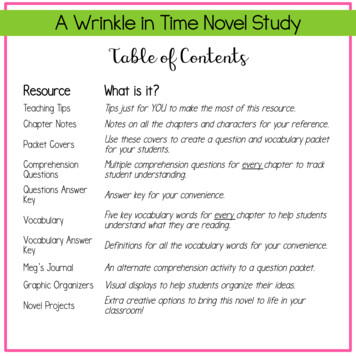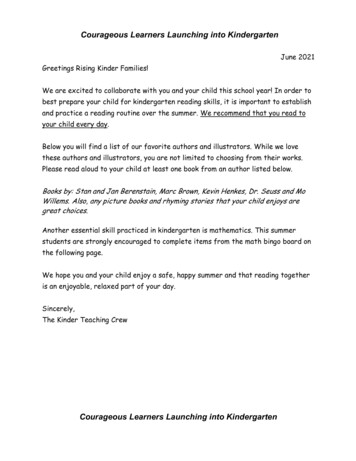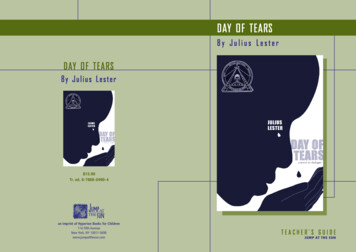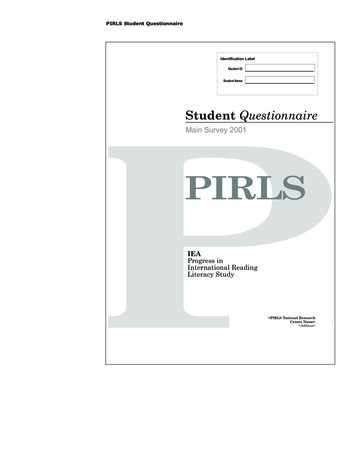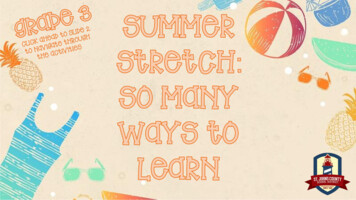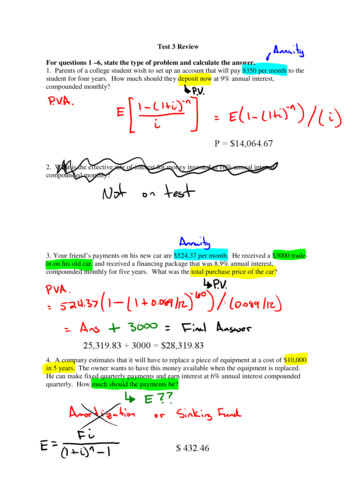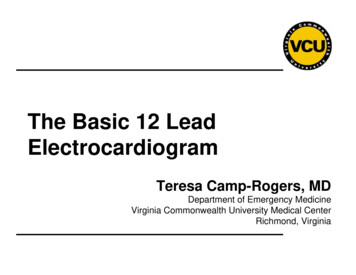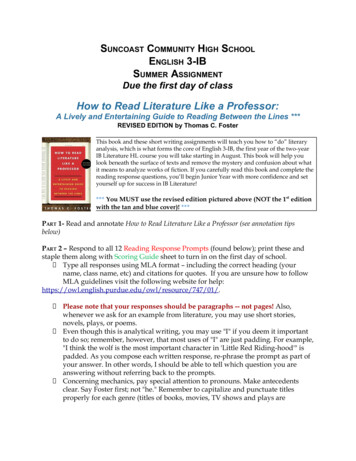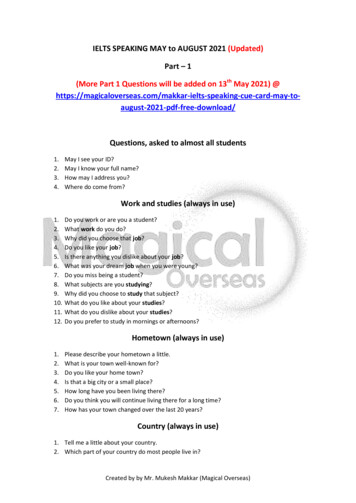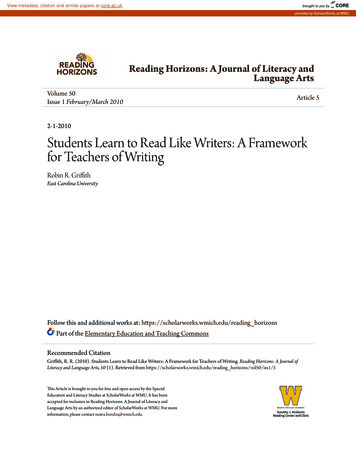
Transcription
View metadata, citation and similar papers at core.ac.ukbrought to you byCOREprovided by ScholarWorks at WMUReading Horizons: A Journal of Literacy andLanguage ArtsVolume 50Issue 1 February/March 2010Article 52-1-2010Students Learn to Read Like Writers: A Frameworkfor Teachers of WritingRobin R. GriffithEast Carolina UniversityFollow this and additional works at: https://scholarworks.wmich.edu/reading horizonsPart of the Elementary Education and Teaching CommonsRecommended CitationGriffith, R. R. (2010). Students Learn to Read Like Writers: A Framework for Teachers of Writing. Reading Horizons: A Journal ofLiteracy and Language Arts, 50 (1). Retrieved from https://scholarworks.wmich.edu/reading horizons/vol50/iss1/5This Article is brought to you for free and open access by the SpecialEducation and Literacy Studies at ScholarWorks at WMU. It has beenaccepted for inclusion in Reading Horizons: A Journal of Literacy andLanguage Arts by an authorized editor of ScholarWorks at WMU. For moreinformation, please contact maira.bundza@wmich.edu.
Students Learn to Read Like Writers: A Framework for Teachers of Writing 49Students Learn to Read Like Writers:A Framework for Teachers of WritingRobin R. Griffith, Ph.D.East Carolina University, Greenville, NCAbstractThis study provides insight into the role of the elementary schoolwriting teacher in helping students learn to “read like writers”(Smith, 1983). This case study documents how one fourth-gradeteacher employed a gradual release of responsibility model as shedeliberately planned activities that drew students’ attention to wellcrafted writing. Findings indicate that this teacher played an important role in helping her students learn to read like writers andthat through carefully crafted lessons she significantly influencedstudents’ knowledge of and implementation of crafting techniques.“Good writing,” as defined by one fourth grader in this study, “feels good toyour ears.” This definition, while brief, encapsulates many of the qualities of goodwriting yet leaves teachers wondering how to help young writers produce the kindof writing that is pleasing to the ear. Writing is a complex process that requiresthe divided attention of the writer, who must focus on the intended message, theconventions of print and spelling, and the crafting of the message with word choiceand sentence variation. Many teachers of writing lament that they are much morecomfortable teaching writing conventions than the writer’s craft, leaving the moresubtle aspects of writing to chance (Fletcher & Portalupi, 1998). Unfortunately, writers cannot fully develop with instruction that focuses only on the conventions ofwriting; rather, instruction must also target the writer’s craft (National Commissionon Writing, 2003). The craft of writing includes the incorporation of literary elements such as strong leads and powerful endings (Fountas & Pinnell, 2001), as
50 Reading Horizons V50.1 2010well as the more subtle aspects of word choice, phrasing, and voice (New ZealandMinistry of Education, 1996).Quality children’s literature holds potential for serving as models for wellcrafted writing and can play an important role in teaching the craft of writing(Avery, 2002; Calkins, 1994; Graves, 1983; Ray, 1999). Frank Smith (1983) explainsthat a great number of children learn to write with only a small amount of instructional time devoted to writing. Therefore, he believes “it could only be throughreading that writers learn all the intangibles that they know” (p. 558). This notionof reading like a writer is the premise upon which this study is based.While Smith (1983) does not address the role of the teacher in enablingstudents to read like writers, drawing upon the social constructivist theory oflearning, the researcher argues that the teacher plays a critical role in the process.Acknowledging that learning is a social process and is influenced by the socialcontext in which it occurs (Jaramillo, 1996; Palincsar, 1998), the individuals whosurround the learner play a vital role in the learning process. Therefore, the primaryresearch question that guided this study was, “What role does the teacher play inhelping students learn to read like writers?”Reading Like a WriterThe term “well-crafted writing” is synonymous with “good writing;” therefore,the writer must carefully craft the writing so that the reader views it as worthy ofreading (Graves, 2004). Numerous individuals have attempted to define or at leastidentify qualities of good writing, yet the definition is still vague and subjective.Though difficult to define, most individuals agree that they know good writingwhen they hear it. Worsham (2001) believed that good writers appeal to the senses;evoking vivid images and scenes in the mind of the reader. Noted children’s authorMem Fox (1999) stated that good writing comes from writers who care about howtheir writing sounds to the reader. Writers who care, take the time to read everyword, phrase, and sentence aloud over and over, “listening for the slightest hiccup inthe rhythm” (Fox, 1999, p. 195). If writers are to produce good writing themselves,they must develop an ear for recognizing it (Heard, 2002). Burrows, Jackson, andSaunders (1984) found that even young writers could develop an ear for qualitywriting and could learn “to select patterns that give vigor and verve to their writing”(p. 7). The goal of reading like a writer then is to encourage the reader to identify
Students Learn to Read Like Writers: A Framework for Teachers of Writing 51qualities of good writing and to further expand their current repertoire of craftingtechniques (Portalupi, 1999). The ideas of reading like a writer and writing mentorsare relatively new concepts in the school setting but not in the community of professional writers. Many published writers learned to write by studying the work ofother authors (Fearn, 1989; Ray, 1999; Rylant, 1990) and by reading the works of themen and women who were doing the kind of writing they wanted to do (Anderson,2000; Zinsser, 1994).Just as professional writers study examples of other writing pieces in the genrethey are trying to produce (Hillocks, 1986), children can learn about the craft ofwriting by listening to and reading quality literature (Ray, 2004). The awareness ofthe rhythm and cadence that is characteristic of quality writing can be learned byreading (Barrs, 2000; Titus, 1998) and “can determine how we come to think wordsshould sound on the page” (Romano, 2004, p. 6). That awareness of how wordsshould flow together is so strongly influenced by the texts we read that it is difficultto separate ourselves from what we have read. The texts become a part of who we areas writers. Ray (1999) reminds us that, “When we write we are not doing somethingthat hasn’t been done before. Everything we do as writers, we have known in somefashion as readers first” (p. 18).Building on the proclamation made by Frank Smith (1983) that individualsmust read like writers in order to learn all they need to communicate effectively,numerous studies have addressed the effects of reading on children’s writing (Barrs,2000; Calkins, 1985; Dressel, 1990; Eckhoff, 1984; Langer & Flihan, 2000; Lancia,1997; Surmay, 2000). The first group of studies focused on how students’ writingwas influenced by the books they read or by the books read to them. Eckhoff(1984) found that children’s writing mimicked the styles of the books they read. Inthis study, students in one classroom read from Basal A that closely matched the literary style of commercially produced children’s literature. The students in the otherclassroom read from Basal B, which consisted of a simplified, controlled-vocabularystyle typically found in basal series. The results indicated that the Basal A childrenproduced writing with more elaborate sentence structures than the students whoread from Basal B, whose writing was consistent with the simple sentences of theBasal B series. In other words, the students wrote the kind of stories they read. Theywere reading like writers. During an eight week study of 48 fifth graders, Dressel(1990) found that students who listened to high quality literature daily incorporatedmore literary traits than those who listened to literature of lesser quality. In this case,
52 Reading Horizons V50.1 2010children’s writing was not just influenced by what they read but by what was read tothem. Finally, Barrs (2000) analyzed the effects two mentor texts had on the writingof 108 Year 5 students in two London classrooms. By measuring syntactic complexity, Barrs determined that the sentence structures in students’ writing mirrored thoseof the mentor texts. Again, students were reading like writers.Other studies focused more specifically on the elements of craft that studentsborrowed from texts. Calkins (1985) found that young writers included “Aboutthe Author” blurbs and prefaces in their own writing because they noticed thosefeatures in many books they read. Lancia (1997) coined the term “literary borrowing” when students in his second-grade classroom borrowed plot, characters, andplot devices from the classroom literature collection. He found that the structureprovided by published authors served as a “jumping off point” for the student’sown writing. Finally, Langer and Flihan (2000) reported that students who read andstudied poetry incorporated imagery and repetition in their own writing. Whilethese studies reveal that many students do, in fact, learn to read like writers, they dolittle to explain how this happens. Informed by these studies and perspectives, thepurpose of this study was to examine and describe the seemingly critical role of theteacher in helping students read like writers.The StudyThis study was conducted in a fourth-grade classroom at a district charterschool in a large urban school district in the southwest. The ethnic distribution ofstudents at the school was as follows: 10% African American, 69% Hispanic, 18%White, 1% Native American, and 2% Asian/Pacific Islander. Eighty-three percentof the students were classified as economically disadvantaged and 7 percent of thestudents were classified as Limited English Proficient (LEP). The mobility rate was35 percent.Ellen (pseudonyms are used throughout), a fourth-grade teacher, was enteringher sixth year of teaching when this study began. She was selected because she possessed understandings of certain aspects of writing instruction that were critical tothis study. For example, she understood that writing workshop was an instructionalformat used to guide children in the process of writing. Like the workshop approachdescribed by Calkins (1994), in Ellen’s classroom, writing workshop occurred on adaily basis for approximately one hour. Each workshop began with a 10 - 15 minute
Students Learn to Read Like Writers: A Framework for Teachers of Writing 53mini lesson, followed by 30 – 40 minutes of independent writing. The workshopconcluded with a 5-10 minute share time. Within the context of writing workshop,the students had choice in the topic, genre, and audience, which was importantbecause it encouraged students to go beyond formulaic writing, and allowed themto develop their unique writing voices.Though the focus of the study was on the role of the teacher as she helpedstudents learn to employ the craft of writing, evidence was needed that the studentswere, in fact, using the craft elements the teacher taught. Evidence of students’understanding was found in the writing samples the students created on a dailybasis and in the field notes collected during the writing workshop time. Taking intoaccount all elements of writing, quality of the message, use of conventions, andevidence of craft, the teacher nominated six case study students who representedthe range of writing abilities in her classroom — two self-extending writers, two transitional writers, and two early writers (Fountas & Pinnell, 2001).Data CollectionThe researcher adopted the stance of observer as participant, primarily observing the study’s context but carefully selecting moments of participation (Glesne,1999; Merriam, 1988). As a participant observer, the researcher was able to witnessthe phenomenon firsthand (Merriam, 1988) enabling her to make sense of thecomplex classroom context because she saw each piece of the environment thataffected the eventual outcome. Moderate interaction with the participants allowedthe researcher to probe for more information through informal conversations withthe students and teacher. One such interaction was initiated by the teacher at thevery beginning of the study when, after several conferences with students, she approached the researcher and said, “I have a tough group. I have some very reluctantwriters.” A brief conversation ensued about how the teacher was supporting thosereluctant writers. On another occasion, the researcher was observing Anthony, oneof the case study students. His story began with, “One day in the fairly month ofMay ” As she leaned over to read his writing, the researcher was unable to read“fairly” so she asked him what that word was. He said, “Fairly. I took it from thatsong, ‘One day in the fairly month of May’.” He then proceeded to sing the firstfew bars of the song. This interaction allowed the researcher to identify othersources of inspiration that the students were using in their writing. Clinging to theadvice of Wolcott (1990) she “talk[ed] little [and] listen[ed] a lot” (p. 127).
54 Reading Horizons V50.1 2010Data collection began in late August and occurred two to three days a weekfor approximately four months. The final data set included detailed field notes from17 writing workshop lessons, two transcribed writing workshop lessons, transcriptsfrom two teacher and six case study student interviews, and various documentsincluding photographs, writing samples from the case study students, the teacher’sschedule, and a listing of books the teacher reported sharing with her students outside of the writing workshop.Data AnalysisData were analyzed to explore how the teacher helped her students learnabout the craft of writing by reading like writers and how she encouraged studentsto employ those crafting techniques in their own writing. The researcher read thefield notes in their entirety, keeping in mind ideas commonly associated with writing workshop, such as choice, response, routines, and time. These codes were thengrouped into themes of literature, craft, conventions, conditions for writing, routines, and researcher/teacher interactions.After determining the themes in the data, field notes were read again to determine the teacher’s role. Questions that guided this portion of data analysis were:1) What was the teacher doing?; 2) How was she using literature?; 3) How was shecreating conditions for writing?; and 4) How was she teaching students about thecraft of writing? Particular attention was paid to the language the teacher used, thefocus of the mini lessons, the time spent on each part of the writing workshop,and the presentation style of the mini lessons. This portion of data analysis allowed the researcher to describe the teacher’s role as facilitator and mediating agent(Kozulin, Gindis, Ageyev, & Miller, 2003). The codes were subsequently applied tothe transcribed lessons and results were then compared to the field notes, furtherstrengthening the themes.FindingsDuring the initial teacher interview, Ellen stated that she considered herselfto be a writer as prior to her teaching career, she worked as a journalist for a localnewspaper. She revealed that she loved writing in high school and dreamed ofwriting her own book someday. These experiences influenced the way Ellen taughtwriting and shaped the way she taught her students to read like writers. Because shewas a writer herself, she was sensitive to the struggles and challenges that writers
Students Learn to Read Like Writers: A Framework for Teachers of Writing 55face (Graves, 2004), and she made it her goal to show students that writing couldbe fun and rewarding.Ellen adopted a social constructivist approach to learning in that she carefully fashioned a classroom environment that promoted “learning as a social processrather than individual phenomena” (Kozulin, et al., p. 1). She encouraged talk during the writing workshop and supported collaborative learning. The students in herclassroom learned about writing not only from Ellen, but from their peers as well.Interestingly, Ellen’s interactions with the six case study students during thewriting workshop were strikingly similar. Even with the range of abilities from earlywriter to self-extending writer, she treated all of them like accomplished writers.An outside observer would have been unable to detect the differences in writinglevels simply by watching the teacher interact with the students as Ellen expectedall of them to be successful writers and even compared their writing to children’sliterature. For example, when Isaiah, one of the early writers, shared his story, Ellenstated, “That was a good story, almost as good as Pete’s a Pizza” (Steig, 1998). Sheoften spoke to them as fellow writers. On one occasion, Valerie was struggling tokeep her piece focused. During the writing conference, the teacher put herself inthe young writer’s place by saying, “It seems to me that you have three good ideas.I think what I might do is separate them and give each a title.”While the four male case study students tended to be more vocal during thewhole group mini lessons and sharing time, the two female case study students wereequally active during one-on-one conferences. Regardless of the level of the writerwith whom she was conferring, Ellen always let the writer take the lead. Almostevery one-on-one conference began with the student making a comment about his/her writing like, “I don’t know what else to add” or, “I’m trying to think of anotherway to say this.” The main difference among the case study students was the level ofsupport that Ellen provided during some of the writing conferences. The early andtransitional writers sometimes needed more guidance in crafting their writing during the individual writing conferences. For instance, when conferring with Timothyabout his planning web, Ellen noticed that it was very broad, so she asked him tobe more specific. “Will this web help you remember all of the details that you wantto include? You could add other bubbles coming off the family bubble to help jogyour memory.” This suggestion allowed Timothy to move forward as a writer.
56 Reading Horizons V50.1 2010Studying the Art of LanguageEllen was very familiar with Katie Wood Ray’s (1999) framework for supporting the noticing of Wondrous Words and the habit of reading like a writer, as therewas evidence of Ray’s work influencing Ellen’s approach for helping her studentslearn to read like writers. Ray’s (1999) framework consists of five steps: “1) notice;2) make a theory; 3) name it; 4) relate it to other texts; and 5) envision it in yourown writing” (p. 120). Ellen chose a framework of 1) noticing; 2) guided practice;and 3) trying it.In order for young writers to begin employing the writer’s craft in independent writing samples, they must first be made aware of well-crafted writing. Theymust hear the sound of good writing and develop an ear for recognizing it andan eye for noticing it in print. In other words, they must learn to read like writers(Smith, 1983). Accordingly, Ellen spent a great deal of time helping students learnthe craft of writing by recognizing it in well-crafted literature (Ray, 1999). In thesubsequent paragraphs, her approach is first described and examples of ways thatshe developed her students’ understanding of the craft of writing are provided;followed by a description of ways Ellen helped students employ the craft of writingindependently.Helping Students Learn to Read Like WritersEllen’s writing instruction centered on the craft of writing. All of the seventeen mini lessons observed during this study related to craft. Ellen helped her students learn about the craft of writing by providing models of good writing and byasking them to notice well-crafted writing (Ray, 1999). She also deliberately plannedactivities that required them to read like writers. The following examples illustrateher approach.During one mini lesson, Ellen copied a page from the popular picture bookThunder Cake (Polacco, 1997) onto a transparency. After reading the text aloud, shesaid, “Tell me some words that you think are describing words, or naming words,or that just stand out as special.” As the students identified words and phraseslike “grease stained pages,” “surveyed,” “lovingly,” and “scurried,” Ellen underlinedthem on the transparency. By asking the students to notice the words, she conveyedthe message that they, too, could identify good writing. When asked how she drewstudents’ attention to well-crafted writing, Ellen explained:
Students Learn to Read Like Writers: A Framework for Teachers of Writing 57Especially at first, I’m very deliberate about it. If I see somethingthat’s worth pointing out, I will stop and point it out to them. Andnow, I’ve turned over that job to them and so they find things thatthey want to bring up or discuss and talk about.By employing the gradual release of responsibility model (Pearson & Gallagher,1983), she was steadily turning the task of noticing good writing over to the students.This “turning over of responsibility” was especially evident during the sharing time.Ellen sometimes asked, “Did you hear anything you liked in her writing?” Studentsmade comments such as, “It’s a good story because of the details you used.” Ellenencouraged the students to extend their comments:Ellen:Can you give an example?Valerie:Like when the snake went “ssss.” That was really good whenyou did that.As the study progressed, the students began to notice more and more craftelements in their peers’ writing. For example, during sharing time the students noticed interesting phrases in Katherine’s story as they identified the phrases “steamyday,” “strange looking van,” and “stars in my eyes” as well-crafted writing. Ellenrarely needed to comment on the description in a student’s story as the studentsdid it for her. On the final day of observation, Ellen chose to read Appelemando’sDream (Polacco, 1997). She gave each student a note card and explained:Every time you hear something in this story that you think is “Wow,fantastic!” that you think is worth using in your own stories sometime,I want you to jot it down and make a little note to yourself so that atthe end of the book, you’ll be ready to share it with the rest of theclass. By the time I get to the end of this book, I’m assuming and Iexpect that you will have at least a few things written down. As I’mreading you need to be listening carefully to the words that PatriciaPolacco uses. If you hear something in there that you think is reallyspectacular, you need to write it down.Ellen’s language indicated her belief that the students could identify goodwriting and would know when they heard it. Interactions like those described abovetrained students to read like writers and led to the use of those newly discoveredcrafting techniques in their own writing.
58 Reading Horizons V50.1 2010Helping Students Learn to Write Like WritersHelping students learn to read like writers was the first step in helping themlearn to write like writers. Ellen was deliberate about helping them learn to employthe craft of writing. She did this by (a) pointing out well-crafted writing, (b) engaging the students in guided practice, and (c) asking them to “try it” during independent practice (see Figure 1).Figure 1. Reading Like a Writer FrameworkAs an example, after identifying interesting words and phrases from the pagein Thunder Cake (Polacco, 1997), Ellen modeled how to borrow words and phrasesfrom Polacco’s story to create her own original poem. The next part of the lessonserved as guided practice as she reminded the students that it was acceptable toborrow ideas and phrases from other authors if the students used them in theirown way. Using the words they selected as unique and interesting, the studentsand teacher wrote a poem entitled Storm (see Figure 2). Ellen guided the studentsthrough the process:Ellen:Tell me some of the words that kind of go together.Timothy: Black clouds.Ellen:Do I have other words in here that might support theblack clouds idea?
Students Learn to Read Like Writers: A Framework for Teachers of Writing 59Katherine: Thick.Ellen:Let’s start like this, “Thick, black clouds.” (She wrote thewords on the overhead transparency.) In Patricia Polacco’sstory, she didn’t say anything about the clouds being thick.That’s our idea. Is there anything else?Katherine: Thick, black clouds gather.Ellen:Okay. (Wrote “gather” at the end of the line.)By the end of the lesson, the students and teacher had written an originalpoem using some of Polacco’s words.Figure 2. Class Created Poem, StormTo set the idea of borrowing words and phrases from other authors firmlyin the minds of her students, Ellen asked them to write their own Thunder Cakepoems. Each student selected and highlighted twenty of Polacco’s interesting wordsand used some of them to write poems (see Figures 3 & 4). Again, independent practice was used to reenforce and encourage the employment of a crafting strategy.
60 Reading Horizons V50.1 2010Figure 3. Student Created Poem, Stormy DayFigure 4. Student Created Poem, Scared
Students Learn to Read Like Writers: A Framework for Teachers of Writing 61On other occasions, Ellen exposed her students to different ways to beginstories by reading leads from various picture books. After categorizing the differenttypes of leads, Ellen supported her students’ use of these leads by teaching severalmini lessons. She began by askingEllen:Yesterday, we talked about beginnings and revisions ofbeginnings. What does that mean?Anthony: To rewrite the beginningEllen:Why would you do that?Isiah:To try to make a better story.Ellen:Yesterday, we did a “try it.” We talked about lots of differentways to start a story. We focused on “setting” beginnings.Today, I want to read you a different kind [of lead]. I’mgoing to read three examples. See what’s the same.Ellen read the first sentence from Westlandia (Fleischman, 2002), Hey, LittleAnt, (Hoose & Hoose, 1998), and Grandpa’s Teeth (Clement, 1999). After the students identified the lead as a “dialogue lead,” Ellen engaged the students in guidedpractice and asked three students to share the first sentence of the story they werecurrently writing. She then showed the class how to change their first sentences intoa dialogue lead. After the mini lesson, Ellen stated:You are going to do another “try it.” Today, I want you to try a dialogue beginning. You may have to rearrange your ideas a bit. I justwant you to try it. Remember that in Westlandia, the dialogue makesus want to find out why Wesley is so miserable.Ellen taught several more lessons on borrowing words and phrases from otherauthors. By the end of the study, students were borrowing not only from publishedauthors, but from the teacher and fellow students as well. Jasmine incorporated thephrase “mass chaos” into her story after hearing it in Ellen’s, and Missy began herstory with the phrase, “It was a grueling hot day ” The students noticed the similarities between these students’ stories and Ellen’s, but the teacher reassured the classthat it was acceptable to borrow from other authors, including her, as long as theymade the writing their own. Ellen considered this practice favorable and continuedto encourage it and the students obliged by reading like writers and incorporatingthe crafting techniques into their own writing.
62 Reading Horizons V50.1 2010What was Ellen’s role in helping students employ the craft of writing andwrite like writers? This fourth-grade teacher stated that the only way she knew howto teach it was “through read alouds and talking about what you notice.” By surrounding her students with models of good writing, Ellen helped them learn to employ the craft of writing. When asked how her teacher helped her become a betterwriter, case study student Valerie explained that by reading books the teacher helpedthem get topics for writing and ideas for word choice. Ellen taught her students tofollow the lead of successful authors as the practice of borrowing words and phrasesfrom other authors was encouraged. These students understood that, as Josh stated“Even good authors borrow stuff from other books.”As a writer herself, Ellen had a clear vision of where she was headed with herstudents. Her path for getting there was well marked. During her final interview, shestated, “I don’t like to write just for the fun of it, just for myself, but I am a writer.I know how it should flow and I have a good idea of what to do next.” Deliberateteaching drew students’ attention to the writer’s craft and deliberate teaching helpedthem learn to employ it. Using the steps of modeling, supporting with guided practice, and allowing for independent practice, Ellen encouraged the incorporation ofcrafting techniques.Insights into the Role of the Teacher inHelping Students Read Like WritersEllen’s students noticed well-crafted writing because she deliberately plannedfor and engaged them in activities that drew their attention to the words in the texts.Like many other quality teachers of writing, she gave her students multiple opportunities to practice writing. What set her apart from other teachers, though, was theway she supported students in their independent practice. After noticing interestingword choice or a crafting technique, Ellen modeled how a writer might use thetechnique in his or her own writing by engaging them in guided
of reading like a writer is the premise upon which this study is based. While Smith (1983) does not address the role of the teacher in enabling students to read like writers, drawing upon the social constructivist theory of learning, the researcher argues that the teacher plays a critical role in the process.
